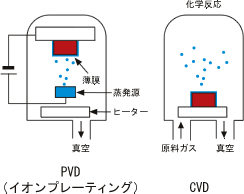ピー‐ブイ‐ディー【PVD】
読み方:ぴーぶいでぃー
ピー‐ブイ‐ディー【PVD】
読み方:ぴーぶいでぃー
物理気相成長法
【英】Physical Vapor Deposition, PVD
物理気相成長法とは、物質の表面に金属の薄膜を生成する手法のうち、物理的効果により被膜を生成する手法のことである。
物理気相成長法では、圧力が低い状態である「高真空」の中で、物質を気体のように原子や分子レベルで動ける状態(気相)にする。その中で金属原子同士をぶつけ、目的とする金属を物質の表面に付着させていき、金属の薄膜の層を形成していく。
物理気相成長法は、ICチップへ被膜する場合などによく用いられている。具体的な物理気相成長法の技術としては、スパッタ法(スパッタリング)などを挙げることができる。
物理蒸着(PVD)・化学蒸着(CVD)
蒸着とは、物質を高温にして蒸発させ、処理物に吸着させその表面上に物質の固体被膜を形成する方法である。
蒸着には大まかに、物理的反応を利用した物理蒸着(PVD)と、化学的反応を利用した化学蒸着(CVD)の二種類がある。
物理蒸着では、蒸発させる金属(蒸発源)を加熱して気化させる。その際、蒸発源を気化しやすくするため、真空近くまで減圧して行う方法を真空蒸着という。気化した金属は、処理物表面に吸着されると、冷却されその表面で固化する。こうして金属被膜が形成されることとなるが、この方法は主に純金属の蒸着に用いられる。例えば、CD(コンパクトディスク)はポリカーボネイトにアルミを蒸着して作られる。
同様に減圧した容器内で、蒸発源と処理物間に電圧をかけ、気化した金属をイオン化して蒸着する方法をイオンプレーティングといい、真空蒸着よりも密着性が高いので、工具や金型へチタン(Ti)やクロム(Cr)の蒸着を行う際良く使用される。
また、減圧容器内で蒸発源と処理物間に高電圧をかけ、同時にアルゴン雰囲気に保つことにより、アルゴンイオンが蒸発源(ターゲットと呼ばれる)に衝突して金属原子が放出され蒸着が行われる。これをスパッタリングといい、真空蒸着では困難な、合金の蒸着が可能であるため近年その用途が広がっている。
化学蒸着では、素材となる反応物質を気化させ、これを反応ガスと混合して反応室内に充填する。反応室内で、ヒーターによって熱された処理物にガスが接触すると、その熱平衡反応によって処理物表面に皮膜を形成される。化学蒸着は半導体製造に不可欠な技術であるが、皮膜のつきが良いことを利して金型などへの蒸着法としても利用される。
化学蒸着においては、電圧をかけることでガスをプラズマ化して行う方法も開発されている。

適している分野・使用事例
PVD=工具へのTi合金蒸着、CD記録面のアルミ蒸着。CVD=半導体製造、工具へのTi合金蒸着、合金の蒸着。
用語解説
PVD
出典: フリー百科事典『ウィキペディア(Wikipedia)』 (2013/01/22 01:53 UTC 版)
PVD
- 物理気相成長(Physical Vapor Deposition)
- T・F・グリーン空港 (ロードアイランド州プロビデンス (ロードアイランド州)、アメリカ合衆国)の空港コード
 |
このページは曖昧さ回避のためのページです。一つの言葉や名前が二つ以上の意味や物に用いられている場合の水先案内のために、異なる用法を一覧にしてあります。お探しの用語に一番近い記事を選んで下さい。このページへリンクしているページを見つけたら、リンクを適切な項目に張り替えて下さい。 |
- PVDのページへのリンク
